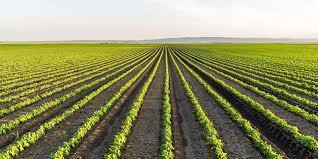Let us have a critical look at the measures of improving field crops production using Nigeria as a case study. Therefore below are some of the basic measures of improving field crops production.
Development of Infrastructure
To achieve accelerated development in food crops production in Nigeria there is need to have a market orientation approach toward production process. Without selling their produce, farmers cannot usually raise enough cash necessary for farm maintenance and improvement , whether in form of a new plough, seed or fertilizer, extra labor or insecticide nor provide for his family.
Markets and prices depend on access to sale points by traders and farmers. A good road transport system is vital in this respect. The fewer and poorer the roads, the lower will be the gain of the farmers, because the cost of moving the farm products will be too high.
Farming communities also need better water supplies. Bringing good quality water nearer the farm reduces the time spent in collecting it. Provision of health care facilities closer to the farmers would enhance their status and productivity.
Development of infrastructure does not itself produce more food but it strengthens and encourages the farming population and also helps to create an enabling environment for crop production to thrive and prosper.
The Incentive Approach
Government need to put in place incentives that would ensure stable prices high enough to stimulate and encourage farmers to produce more. Farm price support has proved very successful in the EU- to the point of over production.
It is hoped that if implemented here, would produce similar results. Because inputs are very expensive for most peasant farmers, incentives are usually necessary if they are to be adopted on a significant scale.
Incentives can take the form of direct subsidy, improve access to credit and granting ownership of land to peasant farmers. However subsidies need to be implemented with care to avoid corruption.
Read Also: The Concept of Animal Production on Agriculture
The Institutional Approach
Government agricultural development agencies are created to help the farmers through training and extension, to implement government policies and monitor performance. But unfortunately such government staffs are poorly motivated and ill-equipped.
Extension services are frequently ineffective due to low morale among extension officers. This may be due to a top-down approach, under-funding, recommendation that is too complex or costly.
In addition there are severe logistical problems in dissemination information to the large numbers of small-scale farmers scattered over the vast areas in the Savanna. Most of the programs for accelerated food production program are typically designed top-down approach instead of bottom- up planning.
That is why most of these programs remain out of touch with farmers’ real constraints and abilities. A ‘them-and us’ mentality develops, so that soon, staff and beneficiaries have different attitudes to and expectation from the project.
There is little identification by the people with the objectives of the program, and no local enthusiasm to take it over and develop it. These are not inevitable results, but avoiding them needs great imagination, careful planning and inspired leadership.
Transfer of Technology and Green Revolution
Transfer of technology could be described as an attempt to overcome local problems with exotic technology. The typical example of transfer of technology is the green revolution.
More accurately referred to as the seed-fertilizer revolution, has centered around the simultaneous adoption of high-yielding varieties and greatly increased levels of chemical fertilization.
Pesticides, especially insecticides, have been required to counteract the greater susceptibility to pest and diseases associated with this combination, and improvements to irrigation and husbandry have frequently been added to the package.
The seed-fertilizer revolution is based, then, on a package of inputs, most of which represent technology transferred from elsewhere but adopted to local condition through regional or national research programmes.
Very large increases in production have resulted from rapid adoption of this technology in a number of countries in Asia and Latin America but with limited successes in Africa south of the Sahara.
Read Also: Trends in Crop Production Nationally and Globally
This is partly due to scarce resources and poorly developed infrastructure to take full advantage of the technology. To take advantage of this technology in sub-Saharan Africa the following need to be put in place:
- Appropriate plant breeding or selection from existing material, concentrating on yield stabilization.
- Establishing efficient and effective seed multiplication system, especially for food crops.
Strengthening communication and infrastructure for marketing of crops and inputs
- Increased use of animal plough in order to overcome labor and timing constraints.
- Involving the farmers more effectively in farming system research and program formulation, implementation and appraisal.
- Greater and consistent commitment to increased food production by national government
As you studied this unit, the historical development of crop production from the stage of hunting and gathering to intensive methods of production would be clear to you. Classification of crops based on botanical similarities and uses, the various centre of origin of important field crops where treated. Treads, problems and prospects of crop production in Nigeria and globally where highlighted and explained.
Summary
Crop production practices are intimately associated with cultural evolution of human beings and have undergone tremendous transformation and development from hunting and gathering stage to modern day intensive field crops production.
Many crops of significance in Nigeria i.e. cassava, maize, sweet potatoes, taro, rice, groundnuts, sugar cane, cocoa and rubber had their origin from other continents but where introduced into Nigeria many years ago.
In this unit field crops where classified according to their botanical similarities, their uses and some special peculiarities. The present condition of field crop production, import and export of cereals in Nigeria, and ranking of the country in world crops production of some crops was presented.
The cassava revolution in Nigeria was equally treated. Constraints and prospects of field crop production in Nigeria where examined and analyzed.
Read Also: The Complete Classification of Crops
